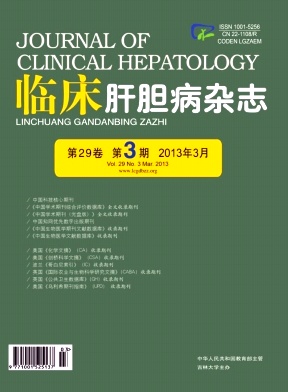|
[1]中华医学会传染病与寄生虫病学分会, 肝病学分会.病毒性肝炎防治方案[J].中华肝脏病杂志, 2000, 8 (6) :324-329.
|
|
[2]Fuchs M, Sanval AJ.Sepsis and cholestasis[J].Clin Liver Dis, 2008, 12 (1) :151-172.
|
|
[3]Fan HB, Chen AS, Yan FM, et al.Clinical analysis of 35 cases ofSepsis-associated cholestasis[J].Chin J Gastroenterol Hepatol, 2010, 19 (4) :367-368. (in Chinese) 樊和斌, 陈安慎, 严福明, 等.感染相关性胆汁淤积症35例临床分析[J].胃肠病学和肝病学杂志, 2010, 19 (4) :367-368.
|
|
[4]Khalil S, Shah D, Faridi MM, et al.Prevalence and outcome ofhepatobiliary dysfunction in neonatal septicaemia[J].J PediatrGastroenterol Nutr, 2012, 54 (2) :218-222.
|
|
[5]Watanakunakorn C, Chan SJ, Demarco DG, et al.Staphylococcusaureus bacteremia:significance of hyperbilirubinemia[J].Scand JInfect Dis, 1987, 19 (2) :195-203.
|
|
[6]Famularo G, De Simone C, Nicotra GC.Jaundice and the sepsis syn-drome:a neglected link[J].Eue J Intern Med, 2003, 14 (4) :269-271.
|
|
[7]Schuppan D, Afdhal NH.Liver cirrhosis[J].Lancet, 2008, 371 (9615) :838-851.
|
|
[8]Kalambokis GN, Tsianos EV.Rifaximin reduces endotoxemia andimproves liver function and disease severity in patients with decom-pensated cirrhosis[J].Hepatology, 2012, 55 (2) :655-656.
|
|
[9]Benjamin J, Singla V, Arora I, et al.Intestinal permeability andcomplications in liver cirrhosis:A prospective cohort study[J].Hepatol Res, 2012, may 25.
|
|
[10]Lu LG.Mechanism of bile secretion excretion, regulaation and cho-lestasis[J].J Clin Hepatol, 2011, 27 (6) :570-580 (in Chi-nese) .陆伦根.胆汁的分泌、排泄和调节及胆汁淤积发生机制[J].临床肝胆病杂志, 2011, 27 (6) :570-580.
|
|
[11]Zhang GX, Sun Y, Sun N, et al.Protective effect of erythropoieti-non lipopolysaccharide induced liver injury in rats[J].J Jilin Vniv (Med Ed) , 2012, 38 (3) :456-460. (in Chinese) 张国兴, 孙宇, 孙霓, 等.促红细胞生成素对脂多糖所致大鼠肝脏损伤的保护作用[J].吉林大学学报:医学版, 2012, 38 (3) :456-460.
|
|
[12]Gentilini P, La Villa G.Liver-kidney pathophysiological interrela-tionships in liver diseases[J].Dig Liver Dis, 2008, 40 (12) :909-919.
|













 DownLoad:
DownLoad: